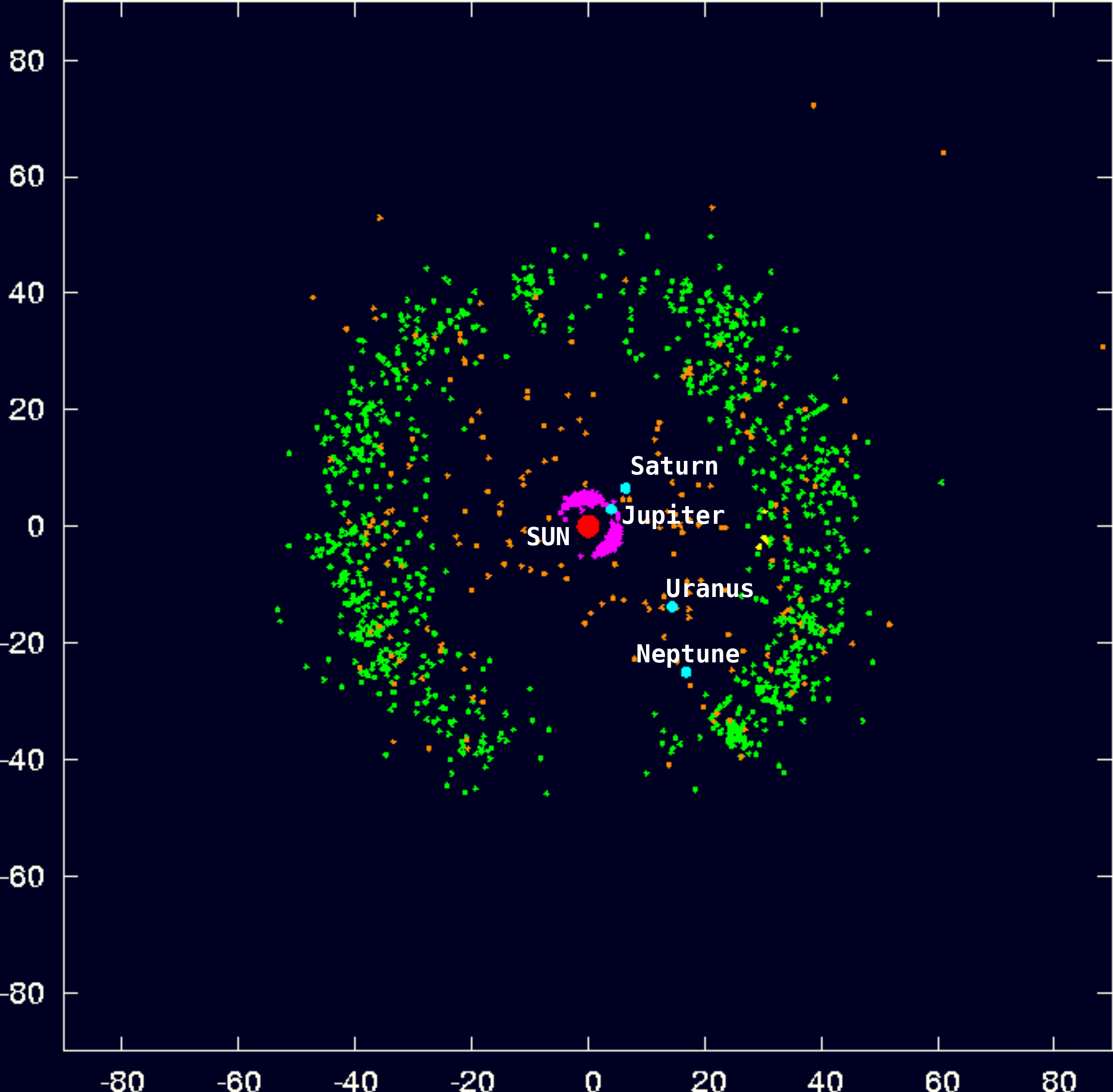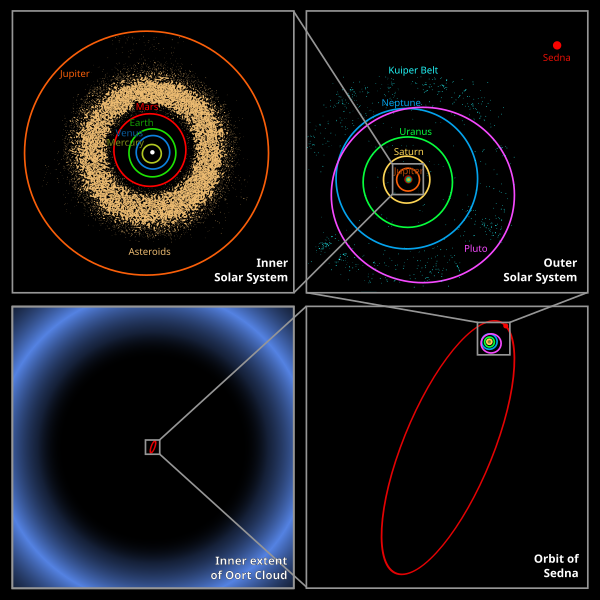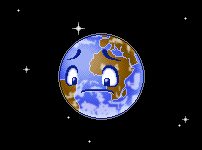That picture above is actually scaled to size but it is impossible to scale the distance in a single image. One way to picture the size of the solar system is to reduce all the sizes to something we can easily imagine. Below is a scale I made if we are going to reduce the Sun to the size of a basketball.
| Solar System Model | |||||
| Body | Body Diam (km) |
Orbit radius (km) |
Body Diam (in) |
Scaled orbit radius (ft & in) |
Scaled orbit radius (meters) |
| Sun | 1391900 | 0 | 9.39 | < Diameter of basketball | |
| Mercury | 4866 | 57950000 | 0.033 | 33 | 9.93 |
| Venus | 12106 | 108110000 | 0.082 | 61 | 18.52 |
| Earth | 12742 | 149570000 | 0.086 | 84 | 25.63 |
| Mars | 6760 | 227840000 | 0.046 | 128 | 39.04 |
| Jupiter | 142984 | 778140000 | 0.965 | 437 | 133.34 |
| Saturn | 116438 | 1427000000 | 0.786 | 802 | 244.52 |
| Uranus | 46940 | 2870300000 | 0.317 | 1614 | 491.83 |
| Neptune | 45432 | 4499900000 | 0.306 | 2530 | 771.07 |
| Pluto | 2274 | 5913000000 | 0.015 | 3324 | 1013.21 |
| Kuiper belt (far edge) | 7479893534.55 | 4205 | 1281.70 | ||
| Ort cloud (far edge) | 7.48E+011 | 420506 | 128170.09 | ||
You can also go to this website and make your own scale computations>http://www.exploratorium.edu/ronh/solar_system/
I know, we are trying to avoid numbers, so here we go.
Look at the picture below and imagine for a moment that the sun is the size of a regular basketball and the earth is the size of peppercorn or like the yellow round pellet below.
Zoom...
Take the yellow pellet and put it 25.6 meters away from the basketball. Roughly that's end to end of a basketball court(which is regularly 28 meters in length). This is the distance between Sun and Earth. Remember that you live in this tiny yellow pellet. Can you imagine how microscopic you are at this scale. Close your eyes and visualize that for a moment. Then imagine Mars the size half of that pellet and put it 39 meters from the ball. Jupiter, at 133 meter away and so on as the list above goes on
To put Pluto in our picture (about grain of sand in size at this scale), you have to travel 1 kilometer and form our basketball. And this is not the edge - there is still the Kuiper Belt and Oort Cloud.
Kuiper belt
The Kuiper belt is a region of the Solar System beyond the planets extending from the orbit of Neptune (at 30 AU) to approximately 50 AU from the Sun (Earth is 1 AU from the Sun to give you an idea of the distances being considered). Like the asteroid belt, it consists mainly of small bodies, or remnants from the Solar System's formation. While the asteroid belt is composed primarily of rock, ices, and metal, the Kuiper objects are composed largely of frozen volatiles (termed "ices"), such as methane, ammonia and water.
Pluto is the largest known member of the Kuiper belt, if the scattered disc is excluded. Originally considered a planet, Pluto's position as part of the Kuiper belt has caused it to be reclassified as a "dwarf planet"(please read from my other post here). It is compositionally similar to many other objects of the Kuiper belt, and its orbital period is identical to that of the KBOs known as "plutinos". In Pluto's honour, the four currently accepted dwarf planets beyond Neptune's orbit are called "plutoids".
The Kuiper belt should not be confused with the hypothesized Oort cloud, which is a thousand times more distant. The objects within the Kuiper belt, together with the members of the scattered disc and any potential Hills cloud or Oort cloud objects, are collectively referred to as trans-Neptunian objects (TNOs).
The Oort cloud
The Oort cloud is thought to occupy a vast space from somewhere between 2,000 and 5,000 AU to as far as 50,000 AU (7.48E+011 km) from the Sun. In our scale, if you put our basketball in Rizal's Monument in Luneta, you need to travel cross the South China Sea pass Hong Kong to Guangzhou China to get to the estimated outer regions of the Oort cloud. Can you still imagine that you are in that now microscopic yellow pellet?
The Oort cloud is thought to comprise two separate regions: a spherical outer Oort cloud and a disc-shaped inner Oort cloud, or Hills cloud. Objects in the Oort cloud are largely composed of ices, such as water, ammonia, and methane. Astronomers believe that the matter composing the Oort cloud formed closer to the Sun and was scattered far out into space by the gravitational effects of the giant planets early in the Solar System's evolution. Some scientists estimates place the outer edge at between 100,000 and 200,000 AU.
So how far the can Solar System go?
The definition of size of the solar system is an ongoing debate among scientist today. There are mutliple theories and here are two most leading.
1. The solar system extends to the reach of the heliosphere, the region where the solar wind interacts with the interstellar medium and it stops the solar wind from our Sun and the solar winds of other stars holds sway.
2. Another widely held theory is that the Solar System exists to the edge of the Sun’s gravitational influence. That is believed to be about 125,000AU or two light years. Beyond that all objects are more strongly influenced by other stars. The problems with this theory is that science is unable to detect objects at that distance and can not determine beyond a reasonable doubt how they are influenced or by what.
As humans who are used to these measurements from day to day experience, it is normal not being able to put our heads around the sizes, distances, and vastness of the solar system. (let alone the the Milky Way or the visible universe). In it's most literal sense they are truly astronomical.












No comments:
Post a Comment